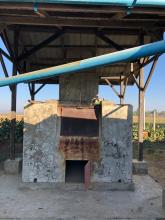The STS is situated in plains, next to the sea, with rivers running through the landscape and a high water table. In the rainy season, many areas are flooded, but not the treatment plant. The sludge has a strong smell, with no foam and is rather liquid. It contains many worms.
Parameter Inlet
Volume (m3) 35
TS (g/l) 14
COD (mg/l) 13500
NH4 (mg/l) 1000
NO3 (mg/l) 70
P (mg/l) 40
E.Coli (CFU/ 100 ml) 6 776 000
Over the years, due to the WASH agencies turnover, there were a variety of pit’ designs constructed in the camps. The most widespread design for containment pits is composed of one watertight pit of a cylinder shape of about 2.65 m3 for each latrine, followed by an infiltration pit of the same size for two latrines, with watertight walls but open at the bottom. Some latrines are each with a 0.6 m3 infiltration pits, in addition to the first pit. Others have two watertight pits of 2.65 m3 in series for each latrine, followed by infiltration trenches. Some latrines have only one pit with watertight walls and no bottom slab. Finally, a new design that is being implemented is similar to the first described, with the infiltration pit walls being constructed with porous concrete (without fines), allowing the water to infiltrate into the ground. Each latrine is designed for an average of 25 users, and each has one or two pits. Some latrines however receive more users because the neighboring latrines are not functioning. They are flush latrines and water is used for anal cleansing. There is a lot of solid waste in the pits. It is removed before desludging activities. The desludging is done with diaphragm and water pumps. The sludge is pumped out of the pit directly into a 1.5 m3 barrel that is located on a tractor. Some latrines are very close to the treatment plant (500m), while the furthest are at about 10km from the treatment plant. It takes up to 2h to travel from the latrines to the plant with the desludging tractors. Desludging is managed by NGOs. The workers are equipped with proper equipment to conduct their work. However, as of now, the desludging needs are not covered as many pits are overflowing. There is no local requirement for the treatment plant discharge value. SI refers to the WHO guidelines that indicate 1000 CFU/100ml for E.Coli concentration and 1egg/ml for Helminth eggs, for reuse in agriculture. There are no local safety requirements. SI follows standard operating procedures, using protection equipment and safety protocols, for the operation of the STS. See the Operator’s manual in annex. The initial design documents are not available. See in annex for the design calculations that were deducted afterwards, as well as from which reference documents the calculations were taken from. The initial production of sludge per person considered for the design is not known, but 0.44 kg/pers.d is considered the current production of sludge. The design was based on the DEWATS design developed by Borda: DEWATS (Decentralised Wastewater Treatment in Developing Countries), Ludwig Sasse 1998. Engineering skills and experience in faecal sludge treatment design are necessary to design a treatment plant similar to the STS. The water table is high during the rainy season (June to September), which leads to a decrease of the infiltration capacity of the ground. Sittwe has a tropical climate, with heavy rainfalls from June to September. The average annual temperature is 25.7 °C. Over the year, the average rainfall is 4664 mm. It is mostly sandy soil, with a good infiltration capacity during the dry season, when the water table is low.





















